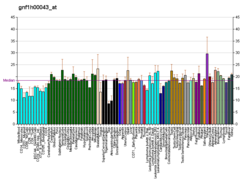DNAH11
Appearance
Dynein heavy chain 11, axonemal is a protein that in humans is encoded by the DNAH11 gene.[5][6]
Function
This gene encodes a member of the dynein heavy chain family. It is a microtubule-dependent motor ATPase and has been reported to be involved in the movement of respiratory cilia. Mutations in this gene have been implicated in causing primary ciliary dyskinesia (PCD, formerly called 'immotile cilia syndrome') and Kartagener syndrome (PCD with situs inversus totalis). Males with PCD are not sterile, but are infertile due to lack of sperm motility.[6] There are reports of subfertility and increased risk of ectopic pregnancy in women with PCD.[7]
References
- ^ a b c GRCh38: Ensembl release 89: ENSG00000105877 – Ensembl, May 2017
- ^ a b c GRCm38: Ensembl release 89: ENSMUSG00000018581 – Ensembl, May 2017
- ^ "Human PubMed Reference:". National Center for Biotechnology Information, U.S. National Library of Medicine.
- ^ "Mouse PubMed Reference:". National Center for Biotechnology Information, U.S. National Library of Medicine.
- ^ Chapelin C, Duriez B, Magnino F, Goossens M, Escudier E, Amselem S (Sep 1997). "Isolation of several human axonemal dynein heavy chain genes: genomic structure of the catalytic site, phylogenetic analysis and chromosomal assignment". FEBS Lett. 412 (2): 325–30. doi:10.1016/S0014-5793(97)00800-4. PMID 9256245.
- ^ a b "Entrez Gene: DNAH11 dynein, axonemal, heavy chain 11".
- ^ Blyth M, Wellesley D (April 2008). "Ectopic pregnancy in primary ciliary dyskinesia". J Obstet Gynaecol. 28 (3): 358. doi:10.1080/01443610802058742. PMID 18569496.





